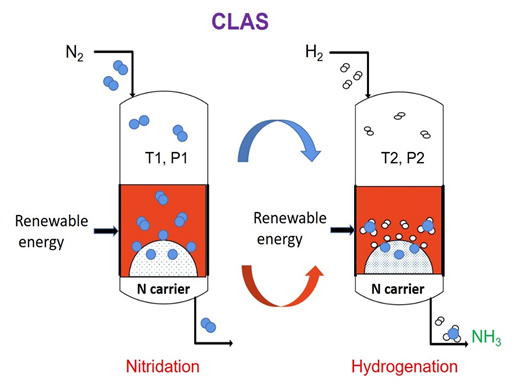摘要/Abstract

氨不仅是氮肥的主要原料,近年来亦被认为是一种具有重要应用前景的"能源载体".现有的Haber-Bosch合成氨工艺是一严重依赖化石能源、高能耗、高碳排放的过程.开发可再生能源驱动的新型"绿色"合成氨过程是实现人类社会可持续发展的重要课题.将合成氨反应解耦为两个或多个分步反应,即化学链合成氨过程,具有易与可再生能源耦合、常压操作、规避反应物竞争吸附等特点,越来越受到业界的关注.本综述阐述了化学链合成氨的发展历史及近期研究进展,重点总结了载氮体材料的研发现状,并对高效载氮体的设计筛选以及化学链合成氨研究所面临的挑战进行了分析和探讨.
关键词: 合成氨, 化学链, 载氮体, 氮化物, 亚氨基化合物
Ammonia is not only the main raw material of nitrogen fertilizer, but also a promising energy carrier for the storage and utilization of renewable energy. The fossil fuel-based Haber-Bosch ammonia synthesis industry is an energy-consuming and high CO2-emission process. For the sustainable growth of human society, it is critically important to develop "green" ammonia synthesis processes driven by renewable energies. This scenario motivates growing interests on ammonia synthesis via heterogeneous catalysis, electro-chemical and photo-chemical routes as well as chemical looping process. Chemical looping ammonia synthesis (CLAS) process involves a series of individual reactions which produce ammonia in a distinctly different manner to the catalytic process. The CLAS could be operated under ambient pressure, and the switching on/off operation is flexible. Therefore, CLAS may be more amenable to variable and intermittent operation compared to the conventional catalytic process. More importantly, the competitive adsorption of N2 and H2 or H2O in the catalytic process can be circumvented to a great extent, which opens new opportunities for the design and development of nitrogen carriers especially for low-temperature ammonia production. Because of these unique features, the application of chemical looping technology for ammonia synthesis has been received increasing attention in recent years. The development of high-efficiency nitrogen carriers is the key component for the implementation of CLAS. A wide range of materials including metal nitrides, metal imides, nitride-hydrides and oxynitrides have been evaluated as nitrogen carriers for CLAS. The knowledge accumulated during the past decade will no doubt beneficial for the further optimization and development of nitrogen carriers. This article reviews the research progress in the field of chemical looping ammonia synthesis in recent years, with the focuses on the materials development of nitrogen carriers in CLAS. Furthermore, the challenges and future directions of CLAS are also discussed. With the development of nitrogen carriers and process design, CLAS would potentially play an important role in the green ammonia synthesis as well as the future energy system.
Key words: ammonia synthesis, chemical looping, nitrogen carrier, nitride, imide
PDF全文下载地址:
点我下载PDF
